- Submissions

Full Text
Novel Research in Sciences
Increasing Castor Seed Oil Content and Seed Weight Using Nuclear Magnetic Resonance Technology and Recurrent Selection
Grace QC*
Department of Agriculture, Western Regional Research Center, USA
*Corresponding author:Department of Agriculture, Western Regional Research Center, USA
Submission: November 06, 2019;Published: November 12, 2019
.jpg)
Volume2 Issue3November, 2019
Abstract
Seed oil of castor bean (Ricinus communis) contains 90% ricin oleic acid which has numerous industrial uses. Increasing seed oil content and seed weight contribute to oil yield and make castor crop production more cost competitive. This review describes an effective procedure that allows to develop a new castor cultivar with increased seed oil content and weight through recurrent selection of high oil content seeds using nuclear magnetic resonance technology.
Introduction
Castor bean (Ricinus communis) is an important oilseed crop producing an uncommon oil with 90% ricin oleic acid (12-hydroxyoleic acid, 18:1OH). The hydroxy group imparts unique chemical and physical properties that make castor oil a vital raw material for manufacturing numerous industrial products, such as high lubricity lubricants and greases, a variety of polymers traditionally made by petroleum-based products for various coatings, elastomers and plastics, and an array of castor oil derivatives utilized in cosmetic industry [1-4]. Seed oil content and weight are important factors to castor oil production. Sprague et al. [5] demonstrated that the oil content can be increased through recurrent selection. The nuclear magnetic resonance (NMR) spectroscopy allowing to determine oil content nondestructively in living seeds [6-8] enables quick identification of desirable seeds for further improvement. Single seed recurrent selection has been demonstrated to be an effective method to increase seed oil content in a number of species such as maize [9], soybean [10], and oat [11]. Hereafter, we review studies [12,13] of rapid development of a new castor cultivar with increased seed oil content and weight using NMR and recurrent selection.
NMR-Based Recurrent Selection for Individual Castor Seeds with High Oil Content
An NMR analyzer can be used to measure the percentage of oil in a living castor seed [12]. Each single castor seed is weighed and placed in an NMR tube and then measured against a calibration curve to determine oil content.
Recurrent selection is performed by the following basic procedures:
1. Individual seeds with high oil content are selected from a base population by screening the base population using NMR
2. Selected seeds are planted, and a new generation of seeds is produced through open pollination
3. The new generation of seeds forms a new population for the next cycle of screening and selection. A schematic procedure for a success recurrent selection [12] is presented in (Figure 1).
Figure 1:Schematic recurrent selection procedure for obtaining high oil content castor seeds.

Table 1:Cycle means, standard deviation (SD), minimum (min), maximum (max)
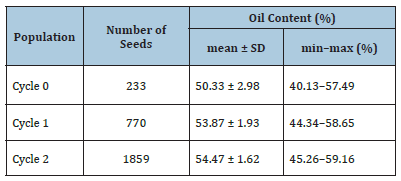
Two Cycles of Selection Increase the Average Oil Content of a Castor Cultivar
As shown in Table 1, the oil content of individual seeds of a base population (Cycle 0) ranged from 40.13% to 57.49% with an average of 50.33%. The top 30 seeds with an oil content of 53% or higher were planted in a greenhouse and 770 mature seeds (or Cycle 1) were collected and analyzed for oil content. The oil content in Cycle 1 ranged from 44.34% to 58.65% with an average of 53.87%. The shift in the mean oil content of Cycle 1 showed a 3.54% increase, with a 95% lower confidence limit of 3.28%. To further improve seed oil content, the top 30 seeds of Cycle 1 with an oil content of 56% or greater were planted in the greenhouse and 1,859 second cycle seeds (Cycle 2) were collected. The oil content in Cycle 2 ranged from 45.26% to 59.16% with an average of 54.47%. Cycle 2 exhibited an increase in mean oil content of 4.14% compared with that of Cycle 0. From Cycle 1 to Cycle 2, a 0.6% increase in mean oil content was observed.
Two Cycles of Selection Reduce Variation in Seed Oil Content of a Population
In addition to the increase of mean oil content, we also observed a reduction of natural variability in oil content after the selection. The base population had a standard deviation of 2.98%, which was reduced to 1.93% in Cycle 1 and 1.62% in Cycle 2. Besides, the range of seed oil content (minimum to maximum) was also reduced from 17.36% in Cycle 0 to 14.31% in Cycle 1 and 13.9% in Cycle 2. Therefore, the average seed oil content was increased because the frequency of seeds with low oil content was reduced and the frequency of seeds with high oil content was increased after selection (Figure 2).
Figure 2:Comparison of frequency distributions of oil content in Cycle 0, Cycle 1 and Cycle 2 of individual castor seeds.
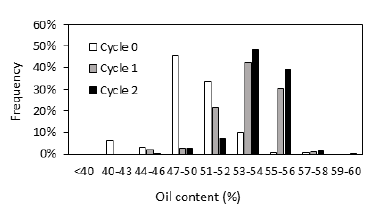
Species Dependent Genetic Ceiling of Seed Oil Content
Based on the survey of 1,033 castor bean accessions from the United States Department of Agriculture (USDA), seed oil content ranged from 37.2% to 60.6% with an average of 48.2% (Wang et al. 2010). The variation range and sample distribution formed a normal distribution with 70% accessions having oil content between 45% and 51% [14]. The base population Cycle 0 had a mean oil content of 50.33% which is comparable to that of most castor accessions. However, after one recurrent selection, Cycle 1 increased oil content to an average of 53.87% which falls into the top 2% of the entire USDA collection. Additional recurrent selection increased the mean oil content to 54.47% which put Cycle 2 at the top 1% of the USDA collection. In our two selection cycles, we observed a quick drop of selection efficiency for oil content. The first cycle increased mean oil content from 50.33% to 53.87%, which is about 7% mean improvement. Whereas the second cycle increased from 53.87% to 54.47%, representing only 1% improvement.
A wide range of selection responses of oil content to number of cycles or generations were reported among species with different genetic background and initial genetic variability. In maize, 54 to 70 genes were estimated to affect oil content [15]. It took 110 cycles of recurrent selection to develop Illinois High Oil strain from mean oil 5% to 20% [9]. Although the number of genes controlling castor oil content is unknown, one possible reason for the lower rate of increase in the second cycle could be a low initial genetic variability in the base population, which may have limited the genetic potential for further enhancement in oil content. A similar phenomenon was reported in soybean [10]. Another possibility could be the existence of a biological upper limit of oil content in castor bean seeds. Among 1,103 USDA castor germplasms, there are only two accessions found to have extremely high oil content (57.1% and 60.6%) [14]. Given that the oil content of Cycle 2 population is among the top 1% castor accessions recorded in the USDA castor bean germplasms, it is likely that our selection process has approached the genetic ceiling of improvement within the species.
Average Seed Weight Increases After Recurrent Selection
Figure 3:Comparison of frequency distributions of seed weight in Cycle 0, Cycle 1and Cycle 2 of individual castor seeds.
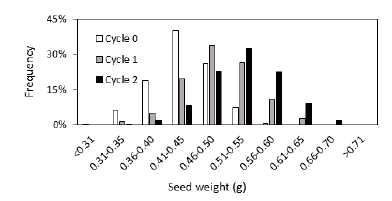
Because seed weight is an important yield component, it is of interest to know if the selection of seeds with higher oil content is associated with a change in seed weight in the populations generated by recurrent selection. As shown in Table 2, single seed weight from base population (Cycle 0) ranged from 0.30–0.56g with an average of 0.44g (± 0.06g, SD) and the correlation between oil content and seed weight was moderate (r = 0.43, p < 0.0001). After selection, the seed weight range increased, showing 0.34–0.65g in Cycle 1 and 0.34–0.71g in Cycle 2 (Table 2, Figure 3) [12,13]. The average seed weight and its correlation with oil content were also increased, showing 0.50 g (± 0.06g, SD) with r = 0.63 (p < 0.0001) in Cycle 1, and 0.54g (± 0.06g, SD) with r = 0.77 (p < 0.0001) in Cycle 2 (Table 2, Figure 3).
Table 2:Cycle means, standard deviation (SD), minimum (min), maximum (max), and correlation (r) between oil content and weight.

The strong correlation after 2 cycles of selection indicated that seeds with higher oil content are frequently associated with heavier seeds. Our results are similar to previous reports of castor bean cultivar BRS Energeia, in which heavier seeds (0.45g / seed) showed higher oil content (54.7%) compared with lighter seeds (0.25g/seed, 48.2% oil content) [16]. Our findings suggest that it might be possible to further increase castor bean seed oil content by screening larger or heavier seeds. Alternatively, when resource is limited, i.e., without an NMR instrument, a population with increased oil content might be developed by screening larger and heavier seeds.
Field Trials Confirm the Success of Recurrent Selection of High Oil Content Seeds
Field trials were conducted for two years [13], the Control seeds were the same batch of seeds as Cycle 0 base population, and the Test seeds were the Cycle 2 population that had showed increased oil content in greenhouse settings. There is no significant difference in the data obtained between Controls A and B, between Tests A and B, or between Years 1 and 2 (Table 3, Figures 4 & 5) [13]. Therefore, data from Control seeds or Test seeds are pooled for a succinct description here. The oil content of Control seeds ranges from a minimum of 30.13% dry weight to a maximum of 57.59% dry weight, with an average of 50.5% dry weight, similar to Cycle 0 seeds of 50.3% dry weight [12,17]. Test seeds have oil contents from 30.13 to 59.41% dry weight, with an average of 54.01% dry weight, which is also comparable to the mean oil content of 54.47% dry weight in Cycle 2 seeds. Single seed weight from Control populations ranges from 0.31 to 0.58g, with an average of 0.44g. Test seeds have single-seed weights ranging from 0.31 to 0.64g, with an average of 0.54g.
Thus, the average single-seed weight of Control and Test seeds remains the same as those of Cycle 0 (0.44g) and Cycle 2 (0.54g), respectively [12,17]. There are no significant differences in correlations between oil content and seed weight between Control seeds (r = 0.43 or 0.44, p < 0.0001) (Table 3) and Cycle 0 (r = 0.43, p < 0.0001) [12,17], or between Test seeds (r = 0.71 or 0.72, p < 0.0001) (Table 3) and Cycle 2 (r = 0.77, p < 0.0001) [12,17]. In addition, the frequency distribution of Control seeds and Test seeds for oil content (Figure 4) and seed weight (Figure 5) resembled the corresponding Cycle 0 and Cycle 2 populations [12,17], respectively.
The results of the field test support our previous greenhouse study that recurrent selection through screening of single seeds is an effective method to improve seed oil content and thus seed weight in castor bean. Our studies also support the notion that seed oil concentration is a heritable trait in castor bean, as demonstrated in other crops [8-11]. As oil is the primary product with economic value in castor bean, development of a cultivar with enhanced oil content will provide a new genetic resource for increasing the oil yield of this important crop.
Table 3:Average seed oil content, weight, standard deviation (SD), minimum (min), maximum (max), and correlation (r) between oil content and weight.
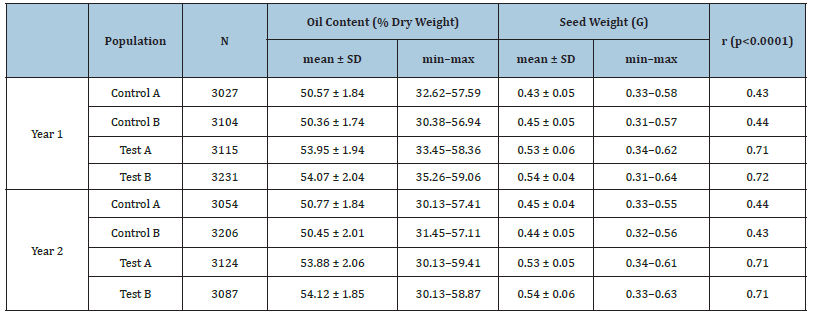
Figure 4:Comparison of frequency distribution of seed oil content. All data are average of duplicates ± SD.
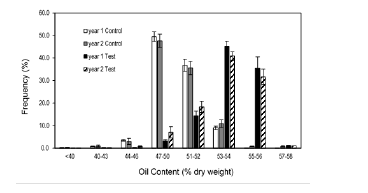
Figure 5:Comparison of frequency distribution of single seed weight. All data are average of duplicates ± SD
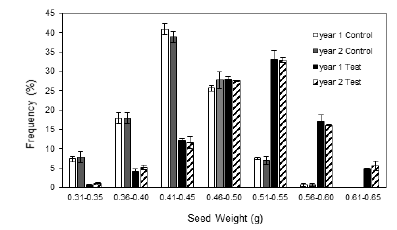
Conclusion
Recurrent selection through screening single seed is an effective method to improve oil content in castor bean. Two cycles of recurrent selection increased the mean oil content of a castor cultivar from 50.33% to 54.47%, reaching levels comparable to those at the top 1% of 1,103 castor bean lines collected by USDA. As a consequent result, we found that seed weight was also increased after recurrent selection and the strong correlation uncovered between seed oil content and weight will allow further improvement of oil content by screening heavier or larger seeds in a population. Given that single seed recurrent selection was successful under field conditions, this method should be applicable to commercial castor bean crops.
References
- Caupin HJ (1997) Products from castor oil: Past, present and future. In: Gunstone FD & Padley FB (Eds.), Lipid technologies and applications. New York, USA, pp. 787-795.
- Sharma V, Kundu PP (2006) Addition polymers from natural oils-A review. Progress in Polymer Science 31(11): 983-1008.
- Hatice M, Michael ARM (2010) Castor oil as a renewable resource for the chemical industry. European Journal of Lipid Science and Technology 112(1): 10-30.
- Johnson W (2007) Final report on the safety assessment of ricinus communis (castor) seed oil, hydrogenated castor oil, glyceryl ricinoleate, glyceryl ricinoleate SE, ricinoleic acid, potassium ricinoleate, sodium ricinoleate, zinc ricinoleate, cetyl ricinoleate, ethyl ricinoleate, glycol ricinoleate, isopropyl ricinoleate, methyl ricinoleate, and octyldodecyl ricinoleate. Int J Toxicol 26(3): 31-77.
- Sprague GF, Miller PA, Brimhal B (1952) Additional studies of the relative effectiveness of two systems of selection for oil content of the corn kernel. Agronomy Journal 44: 329-331.
- Conway TF, Earle FR (1963) Nuclear magnetic resonance for determining oil content of seeds. Journal of the American Oil Chemists' Society 40(7): 265-268.
- Rubel G (1994) Simultaneous determination of oil and water contents in different oilseeds by pulsed nuclear magnetic resonance. Journal of the American Oil Chemists' Society 71(10): 1057-1062.
- Bauman LF, Conway TF, Watson SA (1963) Heritability of variations in oil content of individual corn kernels. Science 139(3554): 498-499.
- Lucas CJ, Han Z, Martha S, Stephen PM (2013) Genomic Changes in Response to 110 Cycles of Selection for Seed protein and oil concentration in maize. Seed Genomics pp. 217-236.
- Feng L, Burton JW, Carter TE, Pantalone VR (2004) Recurrent half-sib selection with testcross evaluation for increased oil content in soybean. Crop Science 44(1): 63-69.
- Frey KJ, Holland JB (1999) Nine cycles of recurrent selection for increased groat-oil content in oat. Crop Science 39(6): 1636-1641.
- Chen GQ, Kumiko J, Eva Morales, Bruce M, Jiann T, et al. (2016) Rapid development of a castor cultivar with increased oil content. Industrial Crops and Products 94: 586-588.
- Chen GQ, Kumiko J, Eva Morales, Ana MI, Jiann T, et al. (2018) A high-oil castor cultivar developed through recurrent selection. Industrial Crops and Products 111: 8-10.
- Wang ML, Morris JB, Pinnow DL, Davis J, Raymer V, et al. (2010) A survey of the castor oil content, seed weight and seed-coat colour on the United States department of agriculture germplasm collection. Plant Genetic Resources 8(3): 229-231.
- Dudley JW (2007) From means to QTL: The Illinois long-term selection experiment as a case study in quantitative genetics. Crop Science 47: S20-S31.
- Severino LS, Mendes BSS, Lima GS (2015) Seed coat specific weight and endosperm composition define the oil content of castor seed. Industrial Crops and Products 75: 14-19.
- Grace C, Kumiko J, Eva Morales, Bruce M (2017) Corrigendum to Rapid development of a castor cultivar with increased oil content. Industrial Crops and Products 101: 103.
© 2019 Spodoptera littoralis. This is an open access article distributed under the terms of the Creative Commons Attribution License , which permits unrestricted use, distribution, and build upon your work non-commercially.
 a Creative Commons Attribution 4.0 International License. Based on a work at www.crimsonpublishers.com.
Best viewed in
a Creative Commons Attribution 4.0 International License. Based on a work at www.crimsonpublishers.com.
Best viewed in 







.jpg)






























 Editorial Board Registrations
Editorial Board Registrations Submit your Article
Submit your Article Refer a Friend
Refer a Friend Advertise With Us
Advertise With Us
.jpg)






.jpg)














.bmp)
.jpg)
.png)
.jpg)










.jpg)






.png)

.png)



.png)






